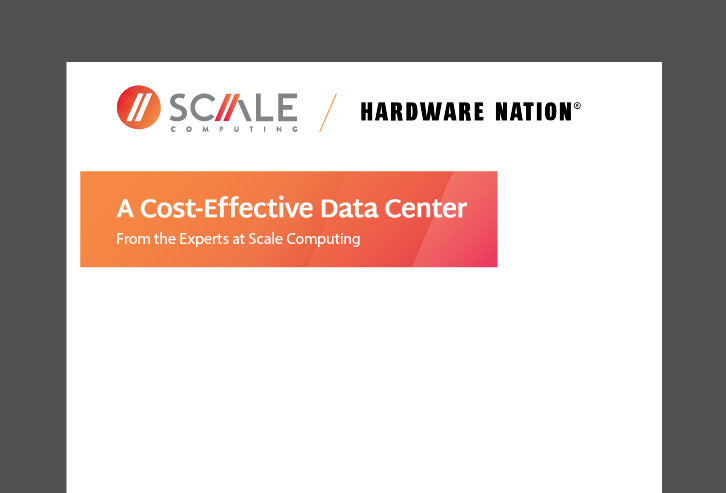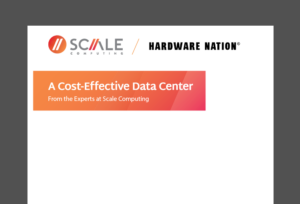Hyperconverged systems completely reinvent the mid-market data center, making the traditional concepts of servers, storage, and virtualization obsolete. In a recent survey, 45% of mid-market businesses indicated they were already far down the path of virtualization.
This white paper has been transcribed below.
A Cost-Effective Data Center From the Experts at Scale Computing
Technical White Paper
What hyperconvergence can offer the SMB
Introduction
Today, businesses, no matter their size, face more challenges than ever. Competitive industries push the need for better technologies to support the business. What happens when that is no longer possible with the technology and infrastructure you have in place today? When does it start to cost you more to manage and maintain your infrastructure than it’s actually worth?
With greater demands on IT departments of every sized business to meet growing data and application needs, infrastructure virtualization has taken on a whole new level of importance. Key to building an optimal business experience, virtualization can enable critical applications to draw from a shared pool of storage and compute resources as needed. If done correctly, it can also allow an enterprise to easily scale up to meet increasing demands. Virtualization is the technology most often used to provide high availability for critical applications, allowing automatic failover to other virtual hosts in the event of a system failure. Although virtualization can bring many benefits, it can also present new challenges to an organization’s IT infrastructure and operations.
Hyperconverged systems completely reinvent the mid-market data center, making the traditional concepts of servers, storage, and virtualization obsolete. These new data center building blocks deliver the seamless consolidation that most midsized companies are looking for. They provide simple, scalable, and available systems that allow you to grow cost-effectively while reducing operational overhead. One such hyperconverged data center building block is Scale Computing Platform. SC//Platform leads the industry in simplicity and cost-effectiveness, all while providing the performance and availability a business requires.
Legacy Infrastructure Won’t Cut It
The benefits of virtualization for any size data center are hard to deny. In fact, in a recent survey, 45% of mid-market businesses indicated they were already far down the path of virtualization. The reality is that if you’re not thinking about it, you’re jeopardizing your company’s critical applications. But it’s a big investment, not only from an upfront Capex cost but also an ongoing Opex cost. Most challenges come in managing legacy complex systems such as VMware, that require more hardware and additional software licensing fees. You also know that your infrastructure is on its last leg, and if your business is growing as fast as its competitors are, the infrastructure you have in place won’t cut it.
Simplified Virtualization for Small to Mid-sized Businesses
Analysts and the industry have coined the term hyperconvergence, which represents an integrated approach to infrastructure that is simple, available and scalable. Hyperconvergence brings together servers, storage, networking, virtualization and easyto-use management software, all in one appliance to deliver just the right infrastructure for your environment at just the right cost.
How does this happen? Usually by leveraging commodity hardware and integrating it with software technology to deliver an automated and highly available virtualization platform. When looking for a vendor that can do this, keep the following capabilities in mind:
Simplicity
The system should automatically handle most daily tasks.
• You no longer should have to manage separate server and storage boxes, from multiple vendors.
• The vendor should provide an easy to use web portal to allow you to provision and configure features, making it easy to deploy VMs within minutes.
• No additional licensing should be required. The system, if designed correctly, should eliminate the need for feature licensing seen in VMware environments.
Availability
High availability should be built in.
• The system should have inherent high availability for each node, providing your business with their applications, all the time.
• It should also provide superior data protection beyond what RAID 10 can deliver, protecting both node and disk failure.
• And finally, VM Failover should be automatic if a node fails.
Scalability
Growth should be cost effective and incremental.
• When you need to expand you should be able to just buy what you need, and pay only as your environment grows. If you need more capacity, just add more nodes.
• The system should be designed to optimize resources as much as possible, and allow you to scale efficiently and cost effectively.
A recent report by TechTarget shows that Virtualization brings a wide range of technological and business benefits to the organization. While consolidating infrastructure and making more efficient use of server resources are driving factors, consider some of the most important and common virtualization benefits:
• Lower cost. Server consolidation lowers the cost of data center hardware as well as facilities.
• Unmatched flexibility. Because every VM exists as its own independent instance on a potentially independent OS, the OS can vary between VMs, enabling the organization to deploy any desired mix of Windows, Linux and other OSes on the same physical hardware.
• Simplified physical infrastructure. With fewer servers, the number of racks and cables in the data center is dramatically reduced. This simplifies deployments and troubleshooting.
• Improved management. Virtualization centralizes resource control and VM instance creation. Modern virtualization adds a wealth of tools and features that give IT administrators control and oversight of the virtualized environment.
• Development and testing. Although server virtualization supports production environments and workloads, the flexibility and ease that virtualization brings to VM provisioning and deployment make it good for development and testing initiatives.
• Higher availability. Virtualization software routinely includes an assortment of features and functionality that can enhance the reliability and availability of workloads running in VMs.
Summary
Hyperconverged infrastructure is not only a buzzword. It is a revolutionary way of thinking about IT infrastructure that reduces IT investments in terms of both money and manpower. Although it may be difficult to determine whether a solution is truly hyperconverged, just converged, or some other pretender, it is worth investigating HCI solutions to make sure your organization can gain the maximum benefit of modern IT infrastructure.
Our team of experts has more than a decade of experience implementing hyperconverged infrastructure solutions. We offer guidance and assess whether an HCI model is appropriate for your unique needs.


